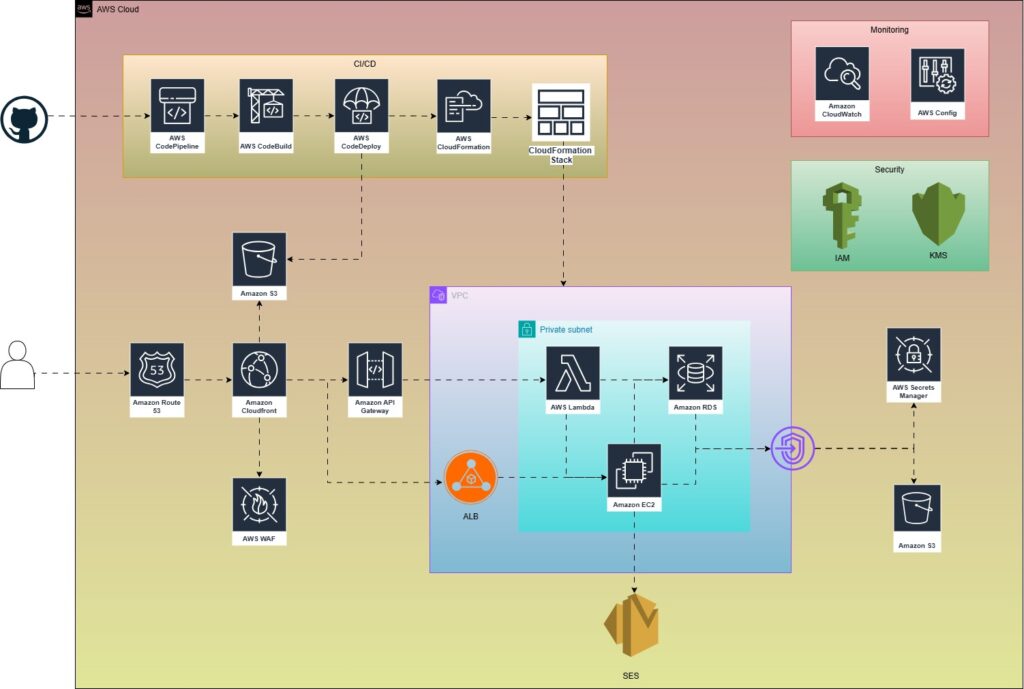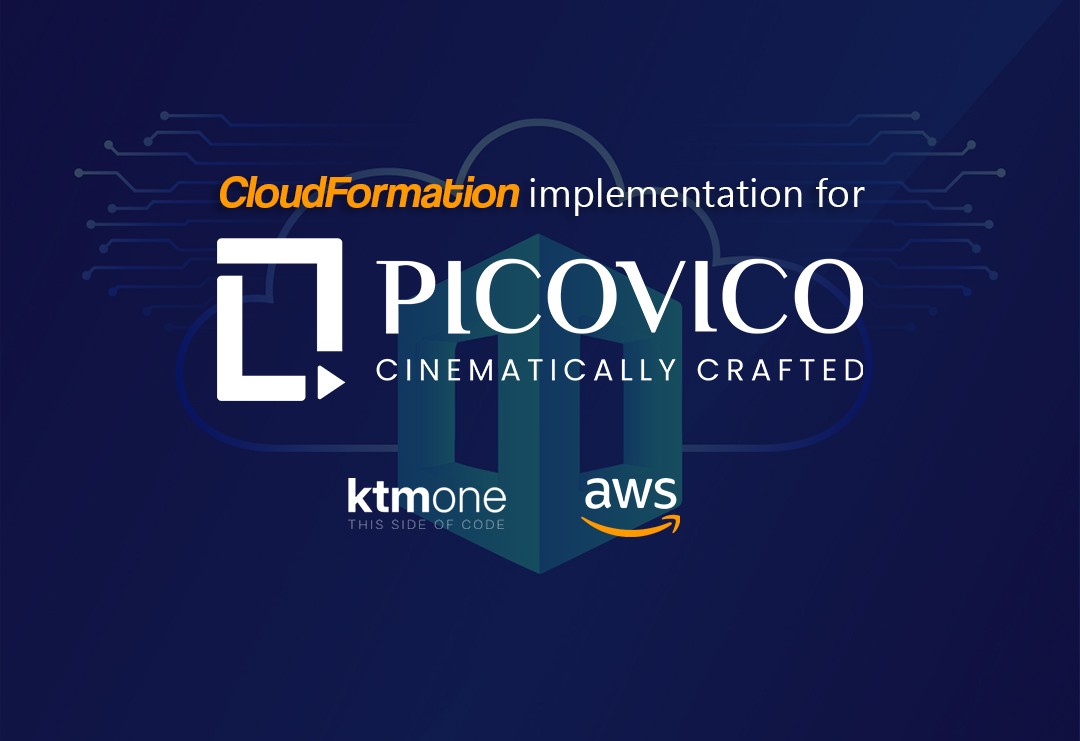About the Client
Picovico, developed by Techtonne Solution, is an innovative all-in-one platform designed to simplify operations for cinema halls and companies. From online ticketing and QR-based scanning to concessions, promotions, and customer engagement, Picovico offers a comprehensive solution that enables cinema operators to manage their businesses more efficiently under a single platform. As the platform grew in popularity and scale, Picovico required a robust and reliable cloud foundation to ensure smooth operations, high availability, and scalability.
Growing Pains: The Need for Smarter Cloud Management
With Picovico’s platform expanding rapidly, managing the cloud infrastructure manually became increasingly complex. Every new feature, customer onboarding, or regional deployment required provisioning multiple AWS resources, including compute, databases, load balancers, networking, and security configurations. Manual provisioning often led to:
● Time-consuming, repetitive tasks for the engineering team
● Risk of human error during configuration changes
● Inconsistent deployments across environments
● Difficulty maintaining version-controlled infrastructure changes
Picovico’s team recognized that as their client base grew, they needed a scalable and automated way to manage their AWS infrastructure while maintaining high availability, security, and cost efficiency.
Simplifying Deployment with AWS CloudFormation
To address these challenges, Techtonne Solution, with expert guidance from KTM One, turned to AWS CloudFormation, AWS’s infrastructure-as-code service. Instead of manually setting up resources, the entire infrastructure was defined through CloudFormation templates that describe what needs to be built, updated, or deleted.
Key benefits CloudFormation brought to Picovico include:
1. Automation of Infrastructure: Complex deployments involving EC2 instances, RDS databases, Elastic Load Balancers, VPC configurations, IAM roles, and security groups are now fully automated.
2. Consistency Across Environments: Whether deploying a new feature to development, staging, or production, the infrastructure remains consistent and reliable.
3. Rapid Scaling: New cinema clients can be onboarded quickly with predefined templates, reducing lead time from days to minutes.
4. Error Reduction: Automated deployment drastically minimizes human error, ensuring stable environments.
5. Change Management: Every infrastructure change is version-controlled, making it easy to roll back if needed.
Why Techtonne Solution Partnered with KTM One
While Techtonne Solution had strong in-house technical expertise, they sought specialized AWS guidance to ensure best practices were followed as they scaled. KTM One, as an AWS Advanced Consulting Partner, brought:
● Deep AWS service expertise
● Hands-on infrastructure design and automation experience
● Best practice guidance for security, cost optimization, and compliance
● Ongoing support and consultation as Picovico’s platform continued to evolve
By collaborating with KTM One, Techtonne Solution was able to accelerate their cloud modernization journey and confidently implement CloudFormation with optimized templates and architecture.
AWS Cloud Architecture

1. Web Protection & Access Control
This section of the architecture ensures that users can access Picovico safely, without being exposed to threats like bots, DDoS attacks, or suspicious traffic.
● AWS WAF (Web Application Firewall): Acting as the digital security guard, WAF protects the application by inspecting incoming HTTP/HTTPS traffic. It filters out bad actors and malicious payloads (like SQL injection or XSS attempts), ensuring only legitimate requests make it through to the application.
● AWS Application Load Balancer (ALB): This is where traffic routing decisions happen. Once WAF approves the request, the ALB determines whether to route it to a Lambda function (for dynamic, serverless logic) or to an EC2 instance (for heavier, persistent workloads). ALB supports path-based routing, so it can smartly decide which backend service should handle what.
2. Core Application Layer
This is where the actual business logic of Picovico lives, the compute engines, storage, and secured processing, all housed in a tightly controlled network environment.
● Amazon VPC: A private, secure network where Picovico’s core services run. This isolates resources from the public internet while still allowing controlled, monitored access via ALB or Lambda triggers.
● AWS Lambda: Serverless functions handle lightweight, scalable workloads like image processing, metadata generation, or triggering email notifications. These functions run in response to events and scale automatically.
● Amazon EC2: Used for more complex, long-running tasks like video rendering, background workers, or services that require specific OS-level configurations. These EC2 instances are protected inside private subnets and integrated with IAM and KMS for secure operations.
● Amazon RDS: The relational database backing Picovico’s core application logic. It stores structured data like user profiles, project metadata, or video drafts, all encrypted at rest and protected via subnets and security groups.
3. Secrets & Security Management
To handle sensitive data like passwords, API keys, and encryption, Picovico uses:
● AWS Secrets Manager: This service safely stores and automatically rotates secrets like database credentials or external API tokens. It integrates directly with Lambda, EC2, and RDS, ensuring credentials never need to be hardcoded into applications.
● AWS KMS (Key Management Service): KMS manages the encryption keys used across the architecture. Whether it’s encrypting logs, secrets, or RDS volumes, KMS ensures compliance and data confidentiality.
4. Monitoring, Auditing & Compliance
It’s crucial to track what’s happening in production both for system health and regulatory reasons. That’s where these services shine:
● Amazon CloudWatch: Acts as the nerve center for logging and metrics. It collects logs from Lambda, EC2, API Gateway, and even custom application logs. It powers dashboards, sets alarms, and helps the Picovico team stay on top of anomalies.
● AWS Config: This is the compliance and drift detection layer. It continuously monitors AWS resources and compares them against desired configurations. If something deviates (like an S3 bucket becoming public), Config alerts the team or even triggers automated remediation.
5. CI/CD & Infrastructure Deployment
Keeping infrastructure consistent and deployments reliable is crucial for a modern DevOps practice. Picovico uses a full AWS-native CI/CD pipeline:
● GitHub: All code, application and infrastructure starts here. Developers push changes to GitHub, which triggers the pipeline.
● AWS CodePipeline: The orchestration layer. It detects changes in GitHub and triggers the necessary build and deployment actions.
● AWS CodeBuild: Builds the application, runs tests, and packages Lambda functions or container images.
● AWS CodeDeploy: Handles safe rollouts of application code. Whether it’s a Lambda update or pushing new code to EC2, CodeDeploy ensures minimal downtime with blue/green or rolling strategies.
● AWS CloudFormation & Stacks: All infrastructure is provisioned and updated using CloudFormation templates versioned and stored alongside application code. This ensures reproducibility and full visibility into the environment at any time.
6. Email Notifications & Communication
● Amazon SES (Simple Email Service): For sending account verifications, user notifications, and system alerts. Integrated with Lambda or EC2, it provides a secure and cost-effective way to communicate with users directly via email.
The Results: Faster Deployments, Stronger Stability
Since adopting CloudFormation with KTM One’s help, Picovico has seen significant improvements across their operations:
● 90% reduction in deployment time for new environments
● Improved security and compliance through standardized configurations
● Faster client onboarding and feature rollouts
● Cost savings by eliminating manual operational overhead
● Easier disaster recovery and rollbacks using version-controlled templates
These improvements allowed Picovico to focus more on developing new features for their cinema clients while spending less time managing the underlying cloud infrastructure.
With a solid CloudFormation-based foundation in place, Picovico is now well-positioned to scale as they onboard more cinema chains and introduce new platform capabilities. Also with KTM One continuing to serve as a trusted AWS partner, Picovico’s future cloud growth is both secure and highly scalable.

